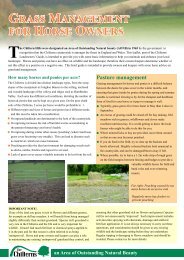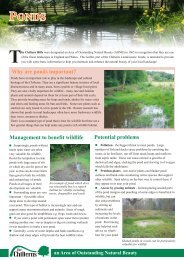on-site sawmilling and timber conversion information ... - The Chilterns
on-site sawmilling and timber conversion information ... - The Chilterns
on-site sawmilling and timber conversion information ... - The Chilterns
You also want an ePaper? Increase the reach of your titles
YUMPU automatically turns print PDFs into web optimized ePapers that Google loves.
3. Forestry Machinery<br />
i<br />
Types of Mill<br />
Static Mills – several types are widely used <strong>and</strong> are either circular or b<strong>and</strong> saw mills.<br />
Static mills may be a small saw bench used <strong>on</strong> a farm for occasi<strong>on</strong>al use or a larger saw<br />
used at a <strong>timber</strong> yard.<br />
C<strong>on</strong>venti<strong>on</strong>al circular saw benches are widely used by many people to c<strong>on</strong>vert <strong>timber</strong>.<br />
<strong>The</strong>y are reas<strong>on</strong>ably simple to use but the saw has to be carefully maintained to achieve<br />
the best results. Maintenance of the circular saw involves both tensi<strong>on</strong>ing (which needs<br />
sawdoctor expertise) <strong>and</strong> sharpening (relatively easy for a trained operator). <strong>The</strong> depth<br />
of cut may be a restricti<strong>on</strong>.<br />
Circular Double Slabbers are simply two circular blades mounted <strong>on</strong> the same bench,<br />
which make two cuts at the same time. This decreases the time to c<strong>on</strong>vert a piece of<br />
<strong>timber</strong> but requires lots of power to run two blades at <strong>on</strong>ce. It can process short lengths<br />
of <strong>timber</strong> quickly but has diameter limitati<strong>on</strong>s. <strong>The</strong>y have fewer teeth compared with a<br />
circular saw, sometimes as few as six. Usually two operators are required for the<br />
double slabber.<br />
Vertical b<strong>and</strong> saws are used at most <strong>timber</strong> yards <strong>and</strong> can process logs over 25cm<br />
diameter <strong>and</strong> 2m in length. <strong>The</strong> b<strong>and</strong>saw blade needs sharpening after several hours<br />
work. B<strong>and</strong> saws produce a thinner cut than other types of mill (down to 1mm thickness)<br />
<strong>and</strong> can work faster. <strong>The</strong>y have a low energy requirement.<br />
Mobile Sawmills<br />
Mobile sawmills are the type of mill that a small woodl<strong>and</strong> owner is likely to use.<br />
<strong>The</strong>re are many different models <strong>on</strong> the market from small, portable saws to trailermounted<br />
saws. Mobile sawmills are useful for cutting round <strong>timber</strong> over 25cm in diameter<br />
<strong>and</strong> 2m in length. Power can be from the mill’s own engine, or from a tractor power<br />
take-off. Some of the sophisticated versi<strong>on</strong>s use a hydraulic system to load the <strong>timber</strong><br />
<strong>and</strong> turn it to meet the saw. Most require just <strong>on</strong>e operator although a sec<strong>on</strong>d pers<strong>on</strong><br />
can help with the loading <strong>and</strong> unloading of the logs <strong>and</strong> <strong>timber</strong> products.<br />
Plate 4. Chainsaw mill in acti<strong>on</strong><br />
Forestry Commissi<strong>on</strong><br />
For more informati<strong>on</strong> <strong>on</strong> the different mobile sawmills models available <strong>and</strong> a<br />
comparis<strong>on</strong> of their performance, refer to the Bibliography <strong>and</strong> Useful Addresses at<br />
the end of this pack.<br />
Chainsaw mills are the cheapest types of mill to purchase. <strong>The</strong>se are very effective at<br />
producing minor amounts of <strong>timber</strong> <strong>on</strong> <strong>site</strong> for the small-scale user.<br />
<strong>The</strong>y are portable <strong>and</strong> easy to set up. Although cheap to buy, they are<br />
slow <strong>and</strong> more waste is generated because of the wide cut of the chain<br />
<strong>and</strong> are therefore not suited to producing valuable <strong>timber</strong>. <strong>The</strong> chain<br />
will have to be filed to a new profile for ripsawing <strong>and</strong> sharpening the<br />
chain can be a l<strong>on</strong>g process because the chainsaw has to be first<br />
dismantled from the mill. <strong>The</strong> chain tensi<strong>on</strong> will need checking as<br />
sawing progresses. Technical versi<strong>on</strong>s are available where the chainsaw<br />
is attached to an aluminium frame <strong>and</strong> is wound al<strong>on</strong>g <strong>on</strong> a rail. <strong>The</strong>se<br />
types of mill have the advantage of making the chainsaw a more versatile<br />
tool from felling the tree to c<strong>on</strong>verting it. You must ensure that you<br />
have a current chainsaw certificate <strong>and</strong> have been properly trained.

















